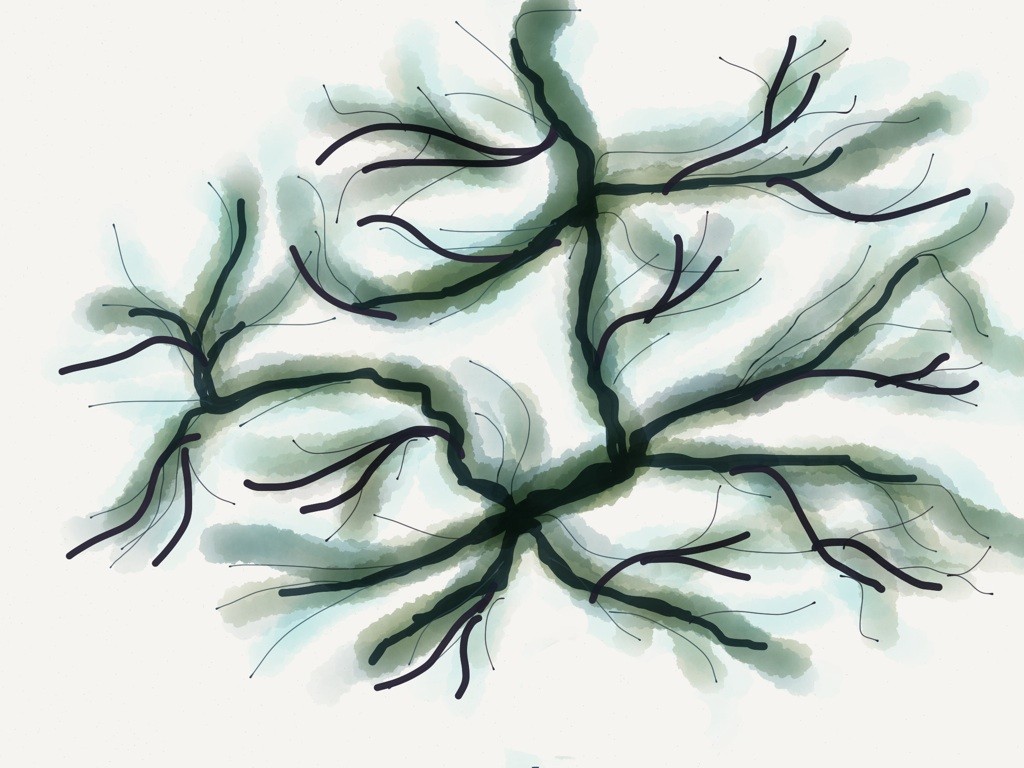I’m partially participating in Website for #rhizo15, an open, online course in rhizomatic learning. During week one, we were asked in a video posted on that site to think about learning subjectives in addition to (instead of?) learning objectives.
The idea seems to be this: we can never be certain exactly what is going to happen in a learning situation, where we’re going to go; we can have a general outline, but things take on a life of their own when we are learning with others. And even the clearest learning objectives are going to be taken differently, interpreted differently, experienced differently by different people.
Here are a few quotes from the video for week one posted on the #rhizo 15 website that are helping me get a handle on what the topic of discussion is:
How do we think about learning and designing for learning when we don’t know where we’re going?…learning is an uncertain process, life is an uncertain place, right answers are things that will only exist in storybooks.
How do we still provide enough structure that people know what we’re talking about?
It is that last point that I really want to focus on here.
I agree with the point that we can’t ever know exactly where we are going to go in learning, and that everyone’s learning experience will be different. Those things seem quite clear. But I worry that at times we might move from there into saying, well then, let’s embrace the chaos and give the least amount of structure possible.
Kind of like the #rhizo15 course itself, for which the idea of the “community as the curriculum” is embodied in (at least) the fact that the only curriculum given by the person who started the course consists of short videos with thought-provoking ideas and questions. What else happens rests entirely on the actions and conversations of the participants–what they talk about, what tools they decide to use to do so (e.g., see this Vialogues discussion about week 2’s video), what artifacts they create. Who would have guessed ahead of time that a blog post with a dialogue (by Tania Sheko) would have led, within about a week or so, to the creation of a radio play? (A project I missed while I was at a conference, and am very sad about missing!)
Now, I’m not knocking this lack of structure as if it’s never appropriate. I think it works great for a course like this, one that people join into because they are simply interested, have some time to dedicate to it, want to connect with others who are thinking about these topics, etc. And it works well for thinking about one’s lifelong learning in general, as evidence by Sheko’s dialogue on her blog. Of course I can’t know for certain where my life is going to go, so it makes no sense for me to have rock-solid learning objectives ahead of time.
But it seems to me that the situation is, perhaps rightly, different for students who are paying for courses for which they are being evaluated in ways that attach to a record that is important for their future. I feel a moral imperative to provide enough structure in a course that they can have a good sense of what they need to do in order to earn the grade they hope to earn. There is a strong power imbalance going on in a “traditional” course where I am in charge of giving grades, and if they don’t get enough information about what the expectations are then I feel like I would be being unfair to them. So it’s vitally important to me to figure out a way to recognize and value the fact that learning is uncertain, and that it would be best if students can find their own paths and their own means of learning (with the community of the rest of us in the class) while still having enough structure that students can have a fair sense of how they will be evaluated and what to do to achieve the marks they hope to achieve.
Now, if learning subjectives are mostly a matter of giving students more choice, more freedom to decide what they want to focus on in classes, then I’m all for that. As Laura Pasquini puts it in a recent blog post,
The openness of learning subjectives provides opportunities for students to drive the course agenda and direct their interests for topics.
This is something I think would be great to do, and I haven’t done as much of that as I’d like in the past. I have offered students the choice of more than one kind of assignment to do in one of my courses (a paper or a more creative project), and I’m also experimenting, in upcoming courses, with students choosing how they want their course grade to be calculated–which assignments to count for what. I also want to involve students more in assessing their own work (I already have them engage in peer feedback quite often), so that they take more ownership of it than just relying on the instructor to assess it.
I’m also happy to say to my students that I’m not sure where our discussions of philosophy or literature are going to go, that we’re going to get together in a room and talk about what we’ve read and see what happens, that I can’t come up with learning objectives for each class meeting because the discussion may take us in directions I can’t predict. That makes sense to me too.
But a certain degree of structure is still crucial when we’re teaching courses for which we are evaluating others in ways that can affect their future, I think. I wouldn’t think it fair to walk into such a classroom and say to students that I don’t know what they’re going to be doing, exactly, or what the curriculum is going to be; all I know is I’m going to start with a couple of readings and questions and we’ll see what happens from there. That’s a fine and very interesting way to run an open online course–I love learning this way in courses like this, and thrive on seeing the unexpected things that happen! I’m not convinced it’s fair to students we are evaluating to do so.
Learning is uncertain, life is uncertain, but I feel strongly that I need to respect the imbalance of power between myself and my students and ensure that they have enough structure to be able to have at least a decent grasp on what the expectations are on which they will be evaluated. Maybe we will work on these expectations, perhaps a marking rubric for essays for example, collaboratively. Maybe we will work collaboratively on where we are going to go in the course, in a general sense. But regardless how we get there, I do think I want to try to direct the rhizome with some structure.
P.S. When I first heard about the notion of “rhizomatic learning,” it was in a presentation by Dave Cormier that included a discussion of how it is not necessarily a lens through which we should view all learning situations. I discuss that in a blog post from 2013, here (jump down to “when is rhizomatic learning appropriate?”). Part of the discussion there was that rhizomatic learning fits well in situations where there are not clear answers, but perhaps is not the way to go when one needs to learn certain basic facts before moving on to more complex domains where the answers aren’t clear. But so far in #rhizo15 I haven’t heard much or anything in the way of saying that maybe rhizomatic learning is good for some contexts but not all. I’m curious if people feel that it’s okay to not be rhizomatic in some contexts, or in some aspects of a course, or when learning certain sorts of things.





